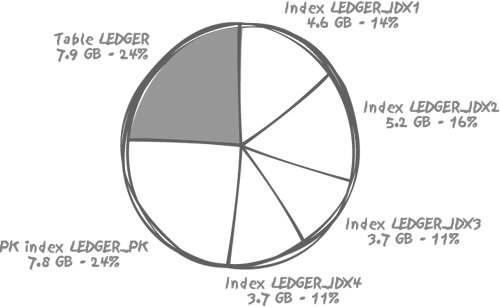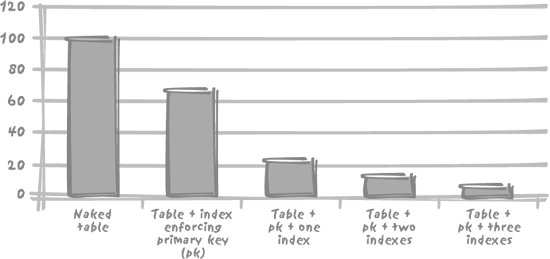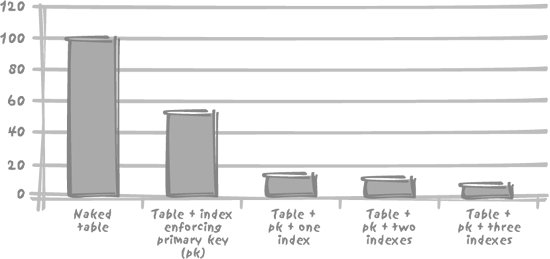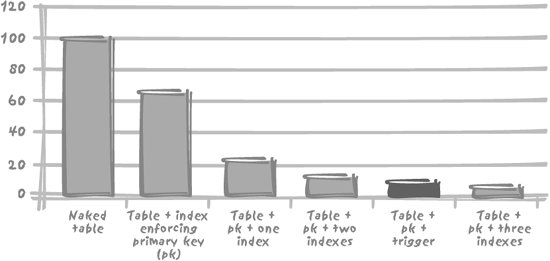Section 3.1. The Identification of
3.1. The Identification of "Entry Points"Even before starting to write the very first SQL statement in a program, you should have an idea about the search criteria that will be of importance to users. Values that are fed into a program and the size of the data subset defined lay the foundations for indexing. Indexes are, above all, a technique for achieving the fastest possible access to specific data. Note that I say "specific data," as indexes must be carefully deployed. They are not a panacea: they will not enable fast access to all data. In fact, sometimes the very opposite is the result, if there is a serious mismatch between the original index strategy and the new data-retrieval requirements. Indexes can be considered to be shortcuts to data, but they are not shortcuts in the same sense as a shortcut in a graphical desktop environment. Indexes come with some heavy costs, both in terms of disk space and, possibly more importantly, in terms of processing costs. For example, it is not uncommon to encounter tables in which the volume of index data is much larger than the volume of the actual data being indexed. I can say the same of index data as I said of redundant table data in Chapter 1: indexes are usually mirrored, backed up to other disks, and so on, and the very large volumes involved cost a lot, not only in terms of storage, but also in terms of downtime when you have to restore from a backup. Figure 3-1 shows a real-life case, the main accounting table of a major bank; out of 33 GB total for all indexes and the table, indexes take more than 75%. Let's forget about storage for a moment and consider processing. Whenever we insert or delete a row, all the indexes on the table have to be adjusted to reflect the new data. This adjustment, or "maintenance," also applies whenever we update an indexed column; for example, if we change the value of an attribute in a column that is either itself indexed, or is part of a compound index in which more than one column is indexed together. In practice this maintenance activity means a lot of CPU resources are used to scan data blocks in memory, I/O activity is needed to record the changes to logfiles, together with possibly more I/O work against the database files. Finally, recursive operations may be required on the database system to maintain storage allocations. Figure 3-1. A real-life case: Data versus Index out of a 33 GB total Tests have quantified the real cost of maintaining indexes on a table. For example, if the unit time required to insert data into a non-indexed table is 100 (seconds, minutes, or hoursit does not really matter for this illustration), each additional index on that table will add an additional unit time of anything from 100 to 250. Maintenance costs for one index may exceed those for one table. Although index implementation varies from DBMS to DBMS, the high cost of index maintenance is true for all products, as Figures 3-2 and 3-3 show with Oracle and MySQL. Figure 3-2. The impact of indexes on insertion with Oracle Figure 3-3. The impact of indexes on insertion with MySQL Interestingly, this index maintenance overhead is of the same magnitude as a simple trigger. I have created a simple trigger to record into a log table the key of each row inserted together with the name of the user and a timestampa typical audit trail. As one might expect, performance suffersbut in the same order of magnitude as the addition of two indexes, as shown in Figure 3-4. Recall how often one is urged to avoid triggers for performance reasons! People are usually more reluctant to use triggers than they are to use indexes, yet the impact may well be very similar. Figure 3-4. Comparing the performance impact of indexes and triggers Generating more work isn't the only way for indexes to hinder performance. In an environment with heavy concurrent accesses, more indexes will mean aggrieved contention and locking. By nature, an index is usually a more compact structure than a tablejust compare the number of index pages in this book to the number of pages in the book itself. Remember that updating an indexed table requires two data activities: updating the data itself and updating the index data. As a result, concurrent updates, which may affect relatively scattered areas of a huge table, and therefore not suffer from any serialization during the changes to the actual data, may easily find themselves with much less elbow room when updating the indexes. As explained above, these indexes are by definition much "tighter" data assemblages. It must be stressed that, whatever the cost in terms of storage and processing power, indexes are vital components of databases. Their importance is nowhere greater, as I discuss in Chapter 6, than in transactional databases where most SQL statements must either return or operate on few rows in large tables. Chapter 10 shows that decision support systems are also heavily dependent for performance on indexing. However, if the data tables we are dealing with have been properly normalized (and once again I make no apologies for referring to the importance of design), those columns deserving some a priori indexing will be very few in a transactional database. They will of course include the primary key (the tuple, or row, identifier). This column (or columns in the case of a compound key) will be automatically indexed simply by virtue of its declaration as the primary key. Unique columns are similar and will, in all probability, be indexed simply as a by-product of the implementation of integrity constraints. Consideration should also be given to indexing columns that, although not unique, approach uniquenessin other words, columns with a high variability of values. As a general rule, experience would suggest that very few indexes are required for most tables in a general purpose or transactional database, because many tables are searched with a very limited set of criteria. The rationale may be very different in decision support systems, as you shall see in Chapter 10. I tend to grow suspicious of tables with many indexes, especially when these tables are very large and much updated. A high number of indexes may exceptionally be justified, but one should revisit the original design to validate the case for heavily indexed tables. In a transactional database, "too many indexes" is often the mark of an uncertain design. |
EAN: 2147483647
Pages: 143